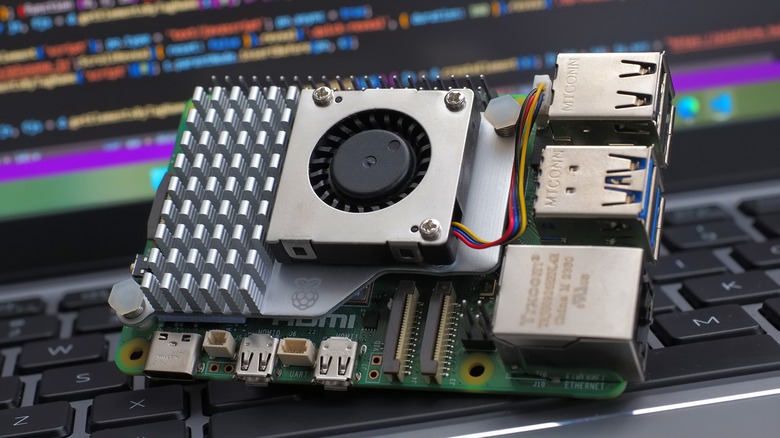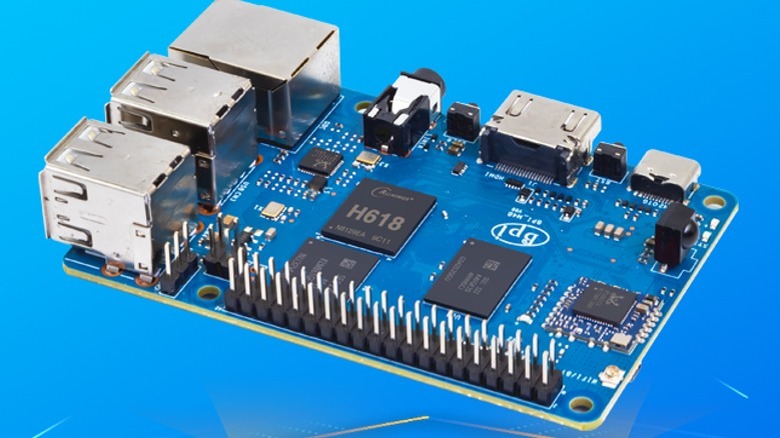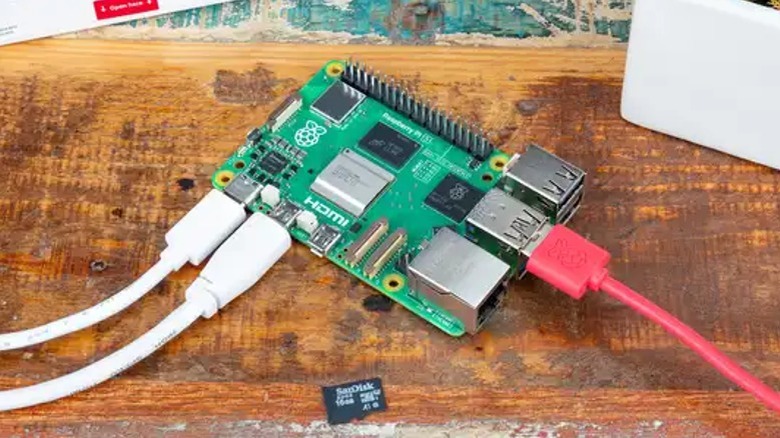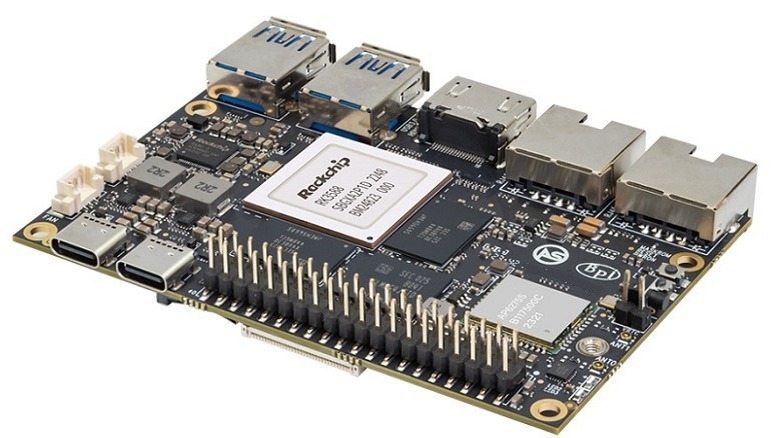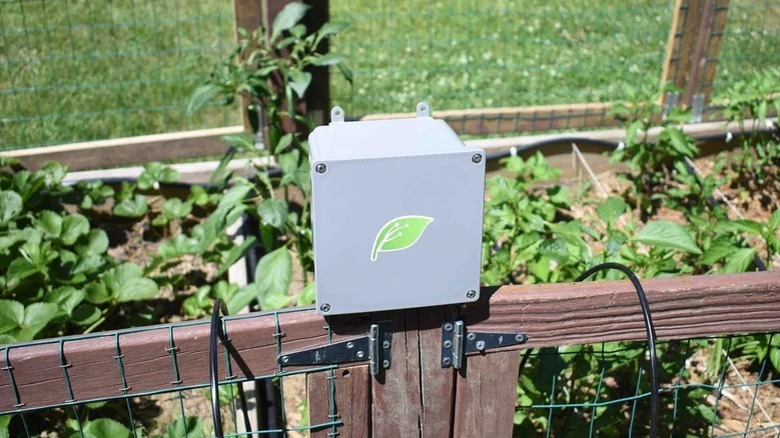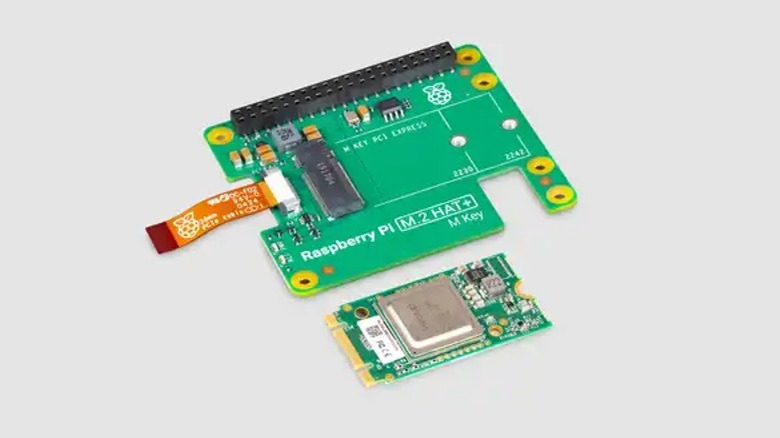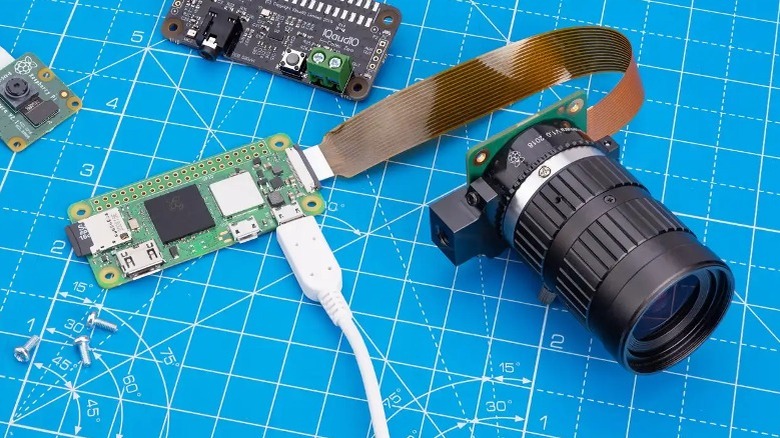Raspberry Pi Vs. Banana Pi: What Are The Differences?
There are a few miniature computer options out there. Raspberry Pi is probably the best-known brand. It's usually the first that comes up in a Google search, and it has the largest community of makers. It isn't the only company making these tiny machines, however. There are several others available as well. You may also have stumbled across Banana Pi, which makes similar products. Both Raspberry Pi and Banana Pi make single-board computers (SBCs) and sound more like a delicious desserts. The products even look fairly similar, with the obvious exception that Banana Pi motherboards are blue while Raspberry Pis are green. So you may understandably wonder what it is that separates these two brands and their products.
In order to fully understand the differences between Raspberry Pi and Banana Pi, we should consider who makes them, what they offer, what kind of specifications their models have, and what projects you will be able to do with them. Knowing that, you should be able to make an informed decision about which of them will be best suited to your next project.
Who makes them?
It's worth taking a look at the companies that make both. Raspberry Pi has been manufacturing and selling small form-factor computers since 2012 when UK-based inventor Eben Upton released his first commercial model. Since then, the company has evolved, offering progressively more powerful models to keep up with the increasing processing requirements. Not only does Raspberry Pi make a wide variety of open-source SBCs and accessories with a suite of compatible open-source software, but it also maintains a forum for makers and programmers to share their projects, encouraging outside development. The Raspberry Pi Foundation–a charity that is dedicated to improving computer literacy, engineering, and programming skills in children also operates under Raspberry Pi LTD, where Upton still holds the reigns as the company's CEO.
The team responsible for Banana Pi was established in 2015. It's led by Guangdong Bipai Technology which is based in Dongguan, China, in collaboration with Taiwan Hon Hai Technology. This company has also built its name by manufacturing open-sourced boards, accessories, and software as well as sharing the architectural design with its consumers. Banana Pi also runs a respectable forum that is full of free project designs. Its overall business model seems very similar to that of Raspberry Pi, with the primary difference simply being its smaller scale.
What models do they offer?
There are 10 Raspberry Pi SBC models currently in production. They are: The Raspberry Pi Zero, Zero W, Zero 2 W, 1 Model A+, 1 Model B+, 3 Model A+, 3 Model B, 3 Model B+, 4 Model B, and the new Raspberry Pi 5. The Pi Zero series SBCs are less powerful than the numbered Pis, but they are also sold at a significantly lower price. This makes them popular options for those who are looking to do projects that require a computer to perform basic processes but don't necessarily need an abundance of memory or processing power. The Pi 5 is on the other end of this spectrum. It's a big step up from the previous generation that even has the processing power to do things like emulate PS2 games.
Banana Pi may not have been around quite as long as Raspberry Pi, but it actually has significantly more units currently in production. There are 25 SBC models currently listed on the company's website. The BPI-M5 gained a lot or popularity over the last couple years when it was seen as a competitor for the Raspberry Pi 4, but the most powerful option the company currently has available is the BPI-M7.
What are their specs?
Next, let's take a look at the specs. It would take too long to go through every single SBC in both companies' respective catalogs, so instead, let's focus on their top performers. The Raspberry Pi 5 is powered by a Broadcom BCM2712 quad-core Arm Cortex A76 processor which clocks in at 2.4GHz and comes in 4GB and 8GB RAM variants. It has a VideoCore VII GPU, dual 4Kp60 HDMI output, a 4Kp60 HEVC decoder, dual-band 802.11ac Wi-Fi, Bluetooth 5.0, Gigabit Ethernet, and several other features besides.
The Banana Pi M7 is powered by a Rockchip RK3588, octa-core 64-bit processor which clocks 2.4GHz as well as a dedicated 6 TOPS NPU for AI processes. It comes in 8GB, 16GB, and 32GB RAM variants and has either a 64GB or a 128GB eMMC for storage built in. It supports WiFi 6, 8K video encoding and decoding, has two 2.5Gb ethernet ports, Bluetooth 5.0, and HDMI 2.1 up to 8Kp60FPS.
These SBCs are both powerful, but the specs indicate that the flagship M7 has the edge in almost every metric, especially when it comes to AI and multi-core tasks. It has double the number of cores, matches frequency, comes in higher memory variants, and even includes a dedicated NPU. This would be bad news for Raspberry Pi if it weren't for the fact that the M7 is so much more expensive.
What kind of projects are out there?
Each of the SBCs made by both of these companies offers a wide variety of different applications, but one of the biggest differences between the two is that the community of private developers designing applications for the Raspberry Pi's hardware, architecture, and software systems is significantly bigger.
In addition to the official Raspberry Pi forum, you can find dozens of projects listed on sites like Reddit, Tom's Hardware, Instructables, All3DP, and even here on SlashGear. There are Raspberry Pi projects out there for your kitchen, home office, garage, hang out spaces, bedroom, back yard, open garden, and just about any other space you can think of. This network of communal resources is one of the brand's biggest selling points.
Banana Pi's community isn't nearly as big. There are a handful of projects for the company's SBCs out there. There are several listed on the official forum and then Ionos and hackster.io each list a dozen or so. It seems that the Banana Pi is much better suited to tinkerers and developers who want to create their own projects than makers who want to follow or adapt pre-designed projects.
What accessory kits are available?
As we mentioned before, mini computers aren't the only products that either of these companies make. Both of them have also developed several accessories and add-on components that are designed to work in conjunction with their SBCs and expand their capabilities.
Raspberry Pi sells dozens of cases, peripherals, cables and cameras. It also sells desktop kits, compute modules, debug probes, HATs, DACs, AMPs, and I/O boards. One of it's more interesting new releases has been the Raspberry Pi AI Kit, which adds a new neural network inference accelerator built around the Hailo-8L chip, giving the Pi 5 machine learning capabilities beyond those of the base SBC.
Banana Pi also has an impressive range of accessories on offer. The company sells a variety of open source router boards for making your own home network, AI boards, IoT boards, and industrial controls. The selection isn't quite as wide, and a quick search on Amazon reveals that there aren't nearly as many third party options designed to work in conjunction with the Banana Pi, however. Many of the third party accessories designed to work with Raspberry Pi SBCs may work with Banana Pis as well, but not many of them are marketed as being compatible and so buying them is a bit of a gamble.
How much do they cost?
One of the most appealing things about SBCs is their relatively low price points. This is what enables most home makers and DIYers to use them in so many different kinds of projects. The Raspberry Pi Zero 2 W is the company's most affordable option, coming in at an MSRP of only $14.99. This makes it ideal for super simple projects that require very little processing power and where the maker is looking to save as much money as possible. The most powerful unit, the Raspberry Pi 5, isn't super expensive either though. You can get the 8GB version for just $79.99. The company's other boards are priced between these two, providing buyers with a wide range power levels to choose from across a moderate range of prices.
Pricing is a little more irregular on the Banana Pis. It's hard to find any of them at standardized prices in the U.S., but you can still find good deals on occasion. The cheapest SBC it makes is the Banana Pi M2 Zero, with it currently available on Amazon for $19.99. This puts it in a similar price category to Raspberry Pi's cheapest option. The M7 isn't even close to the Pi 5's price though. It's listed on Amazon for $214.99, and seems to be similarly priced from other retailers. That's more than three times the price of the Pi 5.
